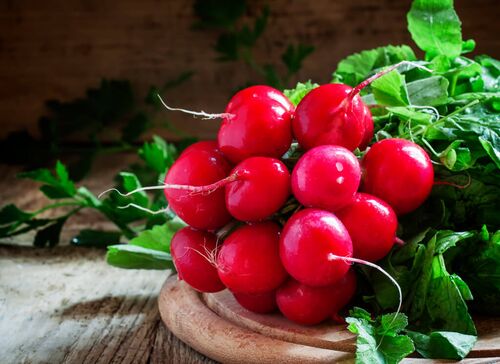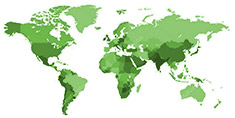Growing Radish

Radish (Raphanus sativus) is a slightly spicy vegetable and is related to cauliflower. It is often used in salads or as a vegetable snack. Radish is also known as one of the best and easiest vegetables to grow for the beginner gardener. We have all the tips and advice you need!
Growing your own radishes
There are many different types of radishes. Most people are familiar with red and white radishes, but there are also yellow, pink and purple radishes. In addition to the spherical shape, you can also grow elongated and carrot-shaped radishes.
Sowing radishes
Radishes are quick, easy and fun to grow from seed. Before you can start sowing radishes, it is important that you buy good radish seeds. In our range we have various types of seeds for sowing radishes.
When to sow radish seeds?
It’s best to sow radishes seeds in the garden about 6 to 4 weeks before you expect the last frost in spring. Radish can be started indoors, but they ( like most root crops ) are difficult to transplant to the garden with success. You can also start sowing radishes later, but they don't taste as good when grown at high temperatures.
Proper Spacing for Radishes
Sow the radish seeds in a sunny place in rows ½ inch deep and 1 inch apart. Thin successful seedlings from 1 to 4 inches apart in wide rows depending upon the variety. After sowing, the seeds will germinate in about 1-2 weeks.
Soil
Radish is also an easy vegetable to grow because it requires little soil. Organic soil or soil enriched with a layer of compost is the ideal bedding for this crop. It’s important to keep the soil evenly moist. If you don't water them evenly (for example, not watering for a few days and then drowning them) the radishes can crack. A great way to keep the soil moist is by mulching with grass clippings, straw or strips of newspaper.
After sowing comes harvesting!
As mentioned earlier, you can harvest the radishes quickly, about 5-6 weeks after sowing. You can begin picking radishes when the roots are about an inch across. Just pull one out to check on the size. If the soil is particularly crusted or hard, use a garden fork or trowel to gently lift the root from the soil. Cut the tops and tail root from the radishes and wash them. Don’t forget about the radish greens! They are also edible and can be stored separately for up to three days. Radishes can be stored in a bowl of water in the refrigerator for 1 to 2 days.
Tips for growing radishes
- Sow different colors and varieties in one place. A huge color surprise awaits you when you harvest the first bunch of radishes.
- Wait a week longer before harvesting to get bigger, sharper radishes.
- To develop a milder flavor, water the radishes extra.
View our range of radish seeds >
Radish Nutrition Facts and Health Benefits
Radishes are not only very tasty, but also very healthy. They are rich in minerals, vitamins C and B, iron and calcium. They also help keep the bladder clean and have mild medical effects on the respiratory tract and skin. The radish leaf is even healthier than the radish itself! It contains the same nutrients, but in greater amounts. For example, you can use it in a salad or on a cheese sandwich.
Did you know?
The oldest discoveries of radishes were made in Egypt. Radishes were paid as wages to the ancient Egyptian laborers who built the pyramids!



